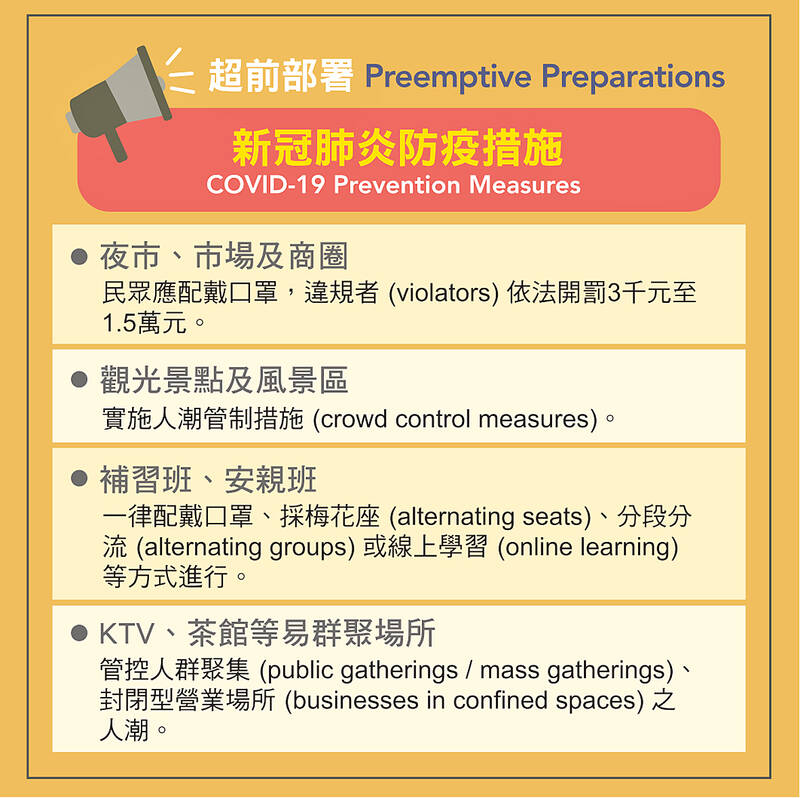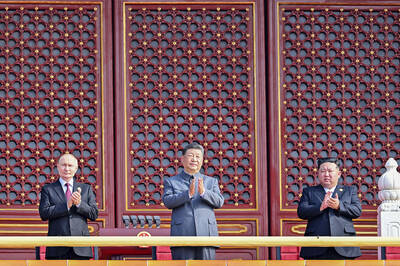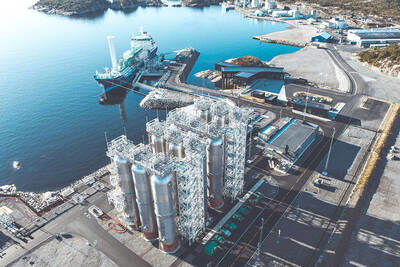在防疫期間,「超前部署」此一用語常見諸報章,成為台灣很夯的熱詞 (buzzword):
超前部署並非2020 年才出現的用語,以下為一些過去台灣政府官員曾使用「超前部署」的語境:
總統馬英九今天指出,八八風災帶來很大教訓,應落實災害防救工作……料敵從寬,禦敵從嚴,超前部署……2010 年 5 月 26 日,《中央社》

Photo/Graphic courtesy of Bookman l 圖片:書林
行政院副院長張善政……表示,蓮花颱風速度雖然減緩……料敵從嚴,並以超前部署為原則……2015 年 7 月 7 日,《新聞傳播處》
《今日科學》有篇文章 “Outbreak science: Infectious disease research leads to outbreak predictions” 就提到做好預判,有利政府防疫的「超前部署」:
Infectious disease outbreaks, whether they be widespread like Influenza or fairly geographically restricted like Ebola, may be difficult to prevent . . . if we can forecast outbreak potential in time, public health officials and governments can preemptively prepare for a potential outbreak event.
傳染病爆發,無論是像流感那樣全面,或像伊波拉那種侷限某些地理區域,都很難預防— 然而,如果我們可以及時預知(疾病)爆發的可能,公衛當局和政府便可以為潛在的疫情爆發提前部署。
Science Daily, January 8, 2020
所以「超前部署」若是在「防災/防疫」的語境下,可譯為preemptive preparation 或 preemptive preparedness,如果用作動詞,可以說 preemptively prepare for (an outbreak, etc.)。
《世界雜誌》上有位作者提到 preemptive 和 preparation 的差異,她說 preemptive 的弦外之音是 heading off something undesirable(避凶/避災):
“Preemptive” and “preparation” both refer to work done ahead of time in order to be ready for something that will or may come. “Preemptive” carries the additional sense of heading off something undesirable. One “prepares” for a camping trip; one “preempts”the flu by getting a vaccination.
“Preemptive preparation” by Andree Seu Peterson, World, March 7, 2014
當然「超前部署」英文也可以有別的表達方式,如:plan(ning) way in advance, plan(ning) way ahead of time 等。若使用 Google search,會發現不同的用法都有一定的使用比例。
不過 plan(ning) way in advance 及 plan(ning) way ahead of time 比較常用在為結婚、度假、活動、事業發展提早做準備,不像 preemptive preparation,有為「避災/避凶」而提前做好應變計畫 (contingency plan) 的意味。
由於新冠疫情,「超前部署」這一時髦詞彙,已成為流行語,用於比較輕鬆的場合,甚至廣告文案、行銷上。某個學會的理監事會上,承辦下一屆研討會的學校代表報告籌備進度,因為那研討會一年半後才要召開,有老師就開玩笑說:「真是超前部署!」在這種情境下「超前部署」就不宜譯為 preemptive preparation,而是 plan(ning) way in advance 及 plan(ning) way ahead of time 更合適了。
防疫必備詞彙:新聞熱詞
熱詞 buzzword
超前部署 preemptive preparation; preemptive preparedness
撤僑專機 citizen evacuation flight
類包機 semi-charter flight
普篩 widespread screening/testing (for COVID-19)
75%酒精 75% alcohol disinfectant
漂白水 bleach
次氯酸水 hypochlorous acid water; hypochlorous acid disinfectant
文章由書林出版公司提供:
www.bookman.com.tw
蘇正隆 — 台灣翻譯學學會前理事長、師大翻譯研究所兼任副教授; 編著《英語的對與錯》,《世紀病毒:必讀防疫英文知識與詞彙》...等

China commemorated 80 years since the end of World War II last week with a massive military parade against a backdrop of a disputed history about who ultimately defeated Japan. The issues, including Japan’s reckoning with its wartime record in China, are bound to flare again in December, a flashpoint anniversary of the mass killing in Nanjing by invading Japanese troops. Below is an explainer about what the different — and disputed — points of view are. WHAT IS CHINA’S VIEW? For the Chinese government sitting in Beijing, this is a clear-cut issue: China sacrificed 35 million people in a heroic and brutal struggle

Rarely does Nature present such a striking contradiction as the one found in Lencois Maranhenses National Park. Located along Brazil’s northeastern coast, the park unveils breathtaking scenery, where rippling sands meet crystal-clear lagoons. Under the sun’s golden glow, the waters glitter in shades of turquoise and emerald. So surreal is this spectacle that visitors might wonder if they’re gazing at a digitally modified photo rather than a living landscape. Were it not for the unique geographical and climatic conditions, such a marvel would not exist. Unlike typical deserts, Lencois Maranhenses receives a substantial amount of rainfall, particularly during the rainy season

In a major step to combat carbon emissions, Norway’s pioneering “Northern Lights project” is set to expand its carbon capture and storage (CCS) capabilities. Backed by energy giants and the Norwegian government, this collaborative project is working to increase its annual carbon storage capacity from 1.5 million to over five million tons. Northern Lights focuses on capturing CO2 emissions from industrial sources across Europe and securely storing them underground. Captured CO2 will be liquefied and transported by ship to the storage facility located off the coast of Norway. It will be injected through pipes into geological formations about 2,600m below the

1. 我和他相識已經九個月了。 ˇ He and I have known each other for nine months. χ I and he have known each other for nine months. 註:單數的不同人稱代名詞連用,其次序一般是 you and I、you and he、he and I、she and I。複數人稱代名詞的次序是 we and you、you and they、we, you, and they。 2. 我自己不願意去那家公司工作。 ˇ I myself am unwilling to work in that company. χ Myself am unwilling to work in that company. 註:myself、yourself、himself、herself、itself、ourselves、yourselves、themselves、oneself 等反身代名詞可用來加強語氣,但必須跟在其所加強的人之後,不能單獨出現當作代名詞用。 I myself went there. I’ll do it myself. He did it himself. 3. 沒有人知道這件事情。 ˇ Nobody knows about this. χ No body knows about this. 註:nobody 不可寫作 no body;同樣 anybody、somebody、everybody 都不可以分開來寫。說「沒有人」,用 no one 或 none 都可以。 4. 我會把自己的書送給他。 ˇ I will give my own book to him. χ I